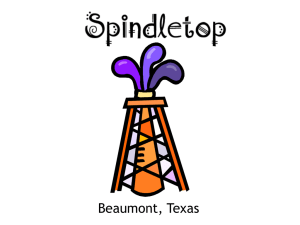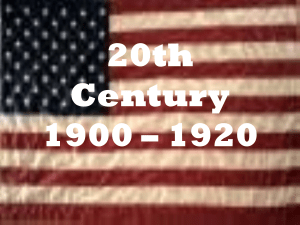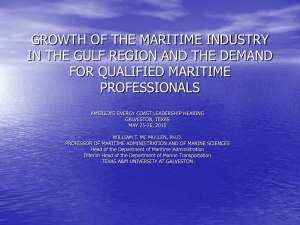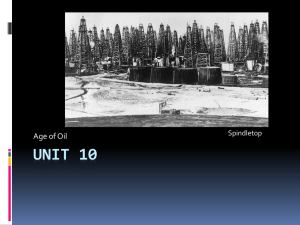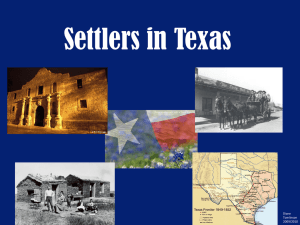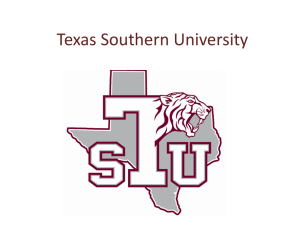Ch. 20 PowerPoint Lecture Notes
advertisement
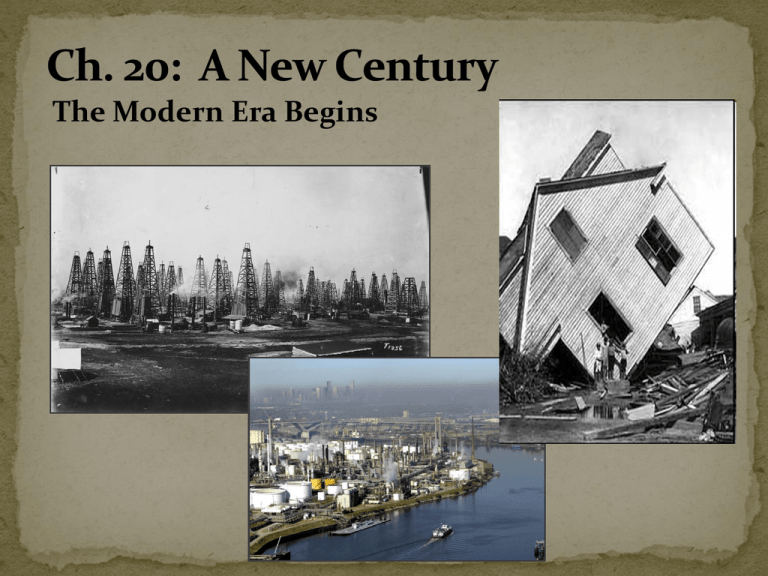
The Modern Era Begins During the late 1800s Galveston was Texas’ most modern city. Galveston was the first Texas city to have electric lights, a telephone and baseball team During the 1800s Galveston was a center for Cotton shipping for Texas and the United States. It grew to be the largest city in Texas by 1870 and remained that way through 1880 with a population of 22,248 people Beautiful architecture adorned the streets of the city, and Galveston enjoyed its role as the financial center of Texas, a true White-Collar City. On Sept. 8, 1900, Galveston was struck by a hurricane of unbelievable force. 120 mph winds and High-cresting tidal waves left more than half of Galveston completely destroyed Nearly 6,000 people died, and of the city left in ruins. Thousands injured and left homeless It was the worst natural disaster in U.S. History! 1900 Storm Path Galveston reformed (changed) its city government to a commission system to speed up the process of recovering A seawall was proposed to block the island from deadly storm surges and the city planned to raise its elevation by bringing in sand from the gulf Galveston built a 17 foot sea wall that extends for over three miles of the islands coastline. They increased the elevation of the town by 16 feet These projects were completed by 1904, causing Galveston to miss out on the oil boom. 1543 - Oil first found in Texas in by survivors of the de Soto Expedition 1866 - First Oil Well in Texas was drilled by Lyne Barret in Oil Springs, Texas. 1890 - Oil Springs has 40 wells, refinery and pipeline to Railroads in Nacogdoches, TX. Brainstorming!! List the uses of petrochemical products: Ink Crayons Parachutes Telephones Tape Antiseptics Purses deodorant Panty hose Rubbing alcohol Rugs Paint Pajamas Hearing aids Motocycle helmets Pillows Shoes Tires Dishwashing liquid Toothbrushes Toothpaste Tents Lipstick Tennis rackets Eyeglasses Life jackets Insect repellent Fertilizers Hair color Toilet seats Speakers Candles Credit cards Apirin Golf balls Trash bags Shampoos Shaving cream Cameras Dentures Pens Nail polish Perfumes Rubber Balloons Footballs Antifreeze insecticides Before 20th Century During 20th Century - Lubrication of - Fuel for gasoline machine parts - Greasing wagon axles - Kerosene for lighting lamps powered automobiles - Fuel for planes, tanks and ships - Fuel for farm equipment - Engine Lubricant Spindletop Hill in Beaumont was located on a Salt Dome Pattillo Higgins and Anthony Lucas struck oil on Spindletop Hill on January 10, 1901 500,000 barrels of oil spewed for six days before the well was capped. Overnight, Beaumont became transformed, as oil prospectors and drillers flocked to the small city. Oil companies like Texas Company (later TEXACO) began, and within a few months, Beaumont’s population grew from about 9,000 to over 50,000 Early Boomtowns were noisy, dirty, crowded, and sometimes dangerous because some of the escaping gas fumes were deadly when inhaled. A new settlement near the refinery joined with Goose Creek and Pelly to become the prosperous Baytown. Question: What does the term “boomtown” mean? Definition: A town undergoing rapid growth due to sudden prosperity. In other words, the population and size of the town “booms” in a very short amount of time. Oil Workers, speculators, gamblers, adventurers all flocked to the oil boom towns like Beaumont Very similar to what happened 30 years earlier in the cowtowns of the Mid-West and in the 1849 Gold Rush. Spindletop led to the rise of a whole new economy and new future for Texas Huge oil Companies were forming Refineries built to refine oil to gasoline Spindletop Oil Field during the boom years of 1910's A depiction of the crowded nature of oil fields during the Oil boom. 500 wells were drilled on 144 acres. Large and small businessmen wanted to make their fortune. The burgeoning oil industry was the Texas equivalent of the California gold rush. By 1903 more than 400 wells were drilling on the Salt Dome. Pipelines and tankers built to carry oil Storage Facilities built to store oil Lumber used to build oil derricks After Spindletop, Oil operators spread their searches throughout Southeast Texas where salt domes were found Oil Fields opened all throughout this region Saratoga Sour Lake Balston 1904 – Drillers discover a salt dome about 20 miles North of Houston, in Humble This was the beginning of the Humble Oil Company, which later became Exxon Company, U.S.A, part of Exxon Corporation Refineries were first located in Humble, then moved to the community of Goose Creek. Located Southeast of Houston close to Galveston Much of the drilling took place in Galveston Bay - offshore Made it easy for ocean shipping A large refinery was built here and the town was later renamed Baytown 1901 – Petrolia-19 miles from Wichita Falls Electra – discovered by cattle rancher W.T. Waggoner had the first big boom in North Texas Burkburnett – 1918– well named ‘Fowler’s Folly’ – gusher that produced thousands of barrels a day Other Oil Discoveries Oil in North Central Texas in 1917 Breckenridege, Mexia, Corsicana, Luling Geologists believed fault zone contained oil in Central Texas. 1922 – Oil workers drilled into a fault near Luling and struck oil The Industry Today! Class discussion: What issues does the Oil Industry face today! 38 The oil boom in southeast Texas created a demand for products needed by oil companies – such as lumber to build the oil derricks and buildings. Lumber operations created thousands of acres of deforested land, which some people believed should have been converted into farmland. Conservationists like W. Goodrich Jones urged replanting of pine trees for trees cut. Many Texas leaders urged the development of additional industries Brickmaking was a successful industry, which used local clay deposits to make high quality bricks. Question: What was the effect of the oil and lumber industries on the environment? Houston – “Where 17 railroads meet the sea” Houston provided banking, insurance, transportation, and legal services for oil companies Gradually Houston became the epicenter of the oil industry In 1914, the Houston Ship Channel opened the city as a modern port Houston Ship Channel 1915 Houston - 1914 Due to it’s central location and many railroad lines, Dallas became the major city of central Texas by 1900. It became a center for shipping, distributing, and storing cotton, as well as other goods. It also became a financial center for banking, insurance, and legal services. Dallas becomes a “White Collar” city Leading retail center for TX, OK, NM Neiman-Marcus department store opened in Dallas in 1907; Sears and Roebuck (later “Sears”), a Chicago mailorder company, opened its southwestern U.S. distribution center in Dallas. Question: Why would Sears and Roebuck choose to locate in Dallas? Assignment When Spindletop blew, people flooded East Texas looking to strike it rich! Advertisements in the newspaper told of the great investments, profits, and benefits of oil. You must create an advertisement to either entice investors, wildcatters or workers to come to East Texas. Advertisement Examples http://chroniclingamerica.loc.gov/lccn/sn84 020274/1902-02-23/ed-1/seq-20/ http://chroniclingamerica.loc.gov/lccn/sn86 071197/1902-03-26/ed-1/seq-9/ http://chroniclingamerica.loc.gov/lccn/sn96 060547/1920-01-31/ed-1/seq-7/

